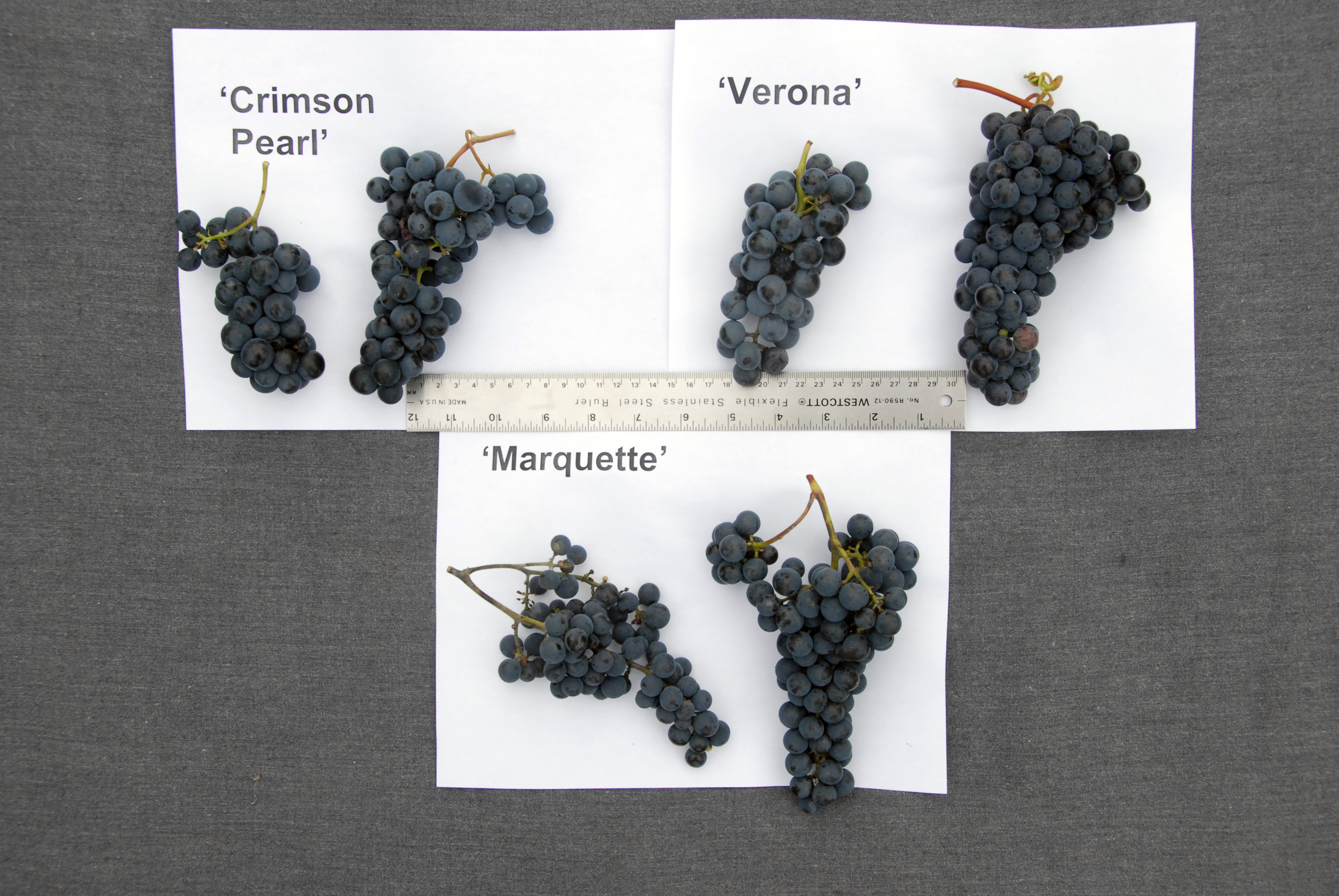Crimson Pearl
| Denomination: | 'Crimson Pearl' |
|---|---|
| Botanical Name: | Vitis |
| Applicant/Holder: |
Plocher, Thomas Alan 9040 - 152nd Street N. Hugo, Minnesota 55038 United States of America |
| Breeder: |
Thomas Alan Plocher, Hugo, United States of America |
| Agent in Canada: |
Variety Rights Management 475 County Road 18 R.R. #2 Oxford Station, Ontario K0G 1T0 Canada Tel: 613-258-9015 |
| Application Date: | 2017-02-08 |
| Provisional Protection:: | 2017-02-08 |
| Application Number: | 17-9097 |
| Grant of Rights Date: | 2020-12-04 |
| Certificate Number: | 6332 |
| Grant of Rights Termination Date: | 2045-12-04 |
Variety Description
Varieties used for comparison: 'Marquette' and 'Verona'
Summary: When 50% of the plants are at bud burst, the young shoot tip of 'Crimson Pearl' is slightly opened whereas the tip of 'Marquette' is closed. The dorsal side of the shoot internodes of 'Crimson Pearl' are green and red whereas those of 'Marquette' are green and those of 'Verona' are red. 'Crimson Pearl' has medium to long tendrils whereas those of 'Marquette' are long to very long. The mature leaf blade of 'Crimson Pearl' is pentagonal in shape whereas it is circular for 'Marquette' and wedge-shaped for 'Verona'. The upper lateral sinuses of the mature leaf blade of 'Crimson Pearl' are shallow to medium depth whereas the sinuses of 'Verona' are absent or very shallow to shallow. The teeth along the margin of the mature leaf blade of 'Crimson Pearl' are of medium length whereas the teeth of 'Marquette' are long. The berries of 'Crimson Pearl' begin to ripen mid to late season whereas those of 'Verona' begin to ripen late to very late in the season. 'Crimson Pearl' has medium to large bunches that are dense to very dense with medium to large berries whereas 'Marquette' has small to medium bunches that are medium to dense with small to medium sized berries. The berry of 'Crimson Pearl' has a medium thick skin whereas that of 'Marquette' has thin skin.
Description:
YOUNG SHOOT TIP: slightly open, absent or very sparse to sparse prostrate hairs, absent or very weak anthocyanin colouration of prostrate hairs, absent or very sparse erect hairs
SHOOT: dorsal side of internodes are green and red, dorsal side of nodes are red, ventral side of internodes and nodes are green, absent or very sparse erect hairs on internodes, semi-erect to horizontal attitude (before tying)
WOODY SHOOTS: orange brown, time of bud burst is late season
TENDRILS: medium to long
YOUNG LEAF: yellow green to green upper side, absent or very sparse to sparse prostrate hairs between main veins on lower side of blade, absent or very sparse erect hairs between main veins on lower side of blade
MATURE LEAF: medium to large blade, pentagonal shape, three lobes, absent or very weak blistering on upper side, upper lateral sinuses of shallow to medium depth, arrangement of lobes of upper lateral sinuses is open, arrangement of lobes of petiole sinus is wide open, length of petiole is equal to the length of middle vein
MATURE LEAF (UPPER SIDE): low proportion of anthocyanin colouration on main veins at petiole base attachment point
MATURE LEAF (LOWER SIDE): absent to very sparse to sparse prostrate hairs between main veins, sparse erect hairs on main veins
TEETH OF LEAF MARGIN: medium length, medium length to width ratio, both sides straight
FLOWER: fully developed stamens and fully developed gynoecium present
BERRY BUNCH: medium to large, dense to very dense, peduncle of primary bunch is medium to long
BERRY: begins ripening mid to late season, medium to large, globose shape, difficult to detach from pedicel, no particular flavour, complete formation of seeds
BERRY SKIN: blue black (without bloom), medium thickness
BERRY FLESH: moderately firm, absent or very weak intensity of anthocyanin colouration
Origin & Breeding History: 'Crimson Pearl' originated from a controlled cross made in 1996 by Thomas Alan Plocher as part of a private breeding program in Hugo, Minnesota between 'MN 1094', as the female parent, and the selection ES.4-7-26, as the male parent. The resulting progeny were initially evaluated based on winter hardiness and suitability for use as a wine grape for northern cold climate production. The final selection of 'Crimson Pearl' took place in 2002 and was based on winter hardiness, timing of bud break as well as for its winemaking characteristics.
Tests & Trials: The comparative trial for 'Crimson Pearl' was conducted at A&M Viticulture in St. Paul d'Abbotsford, Quebec during the fall of 2018 and spring of 2019. A total of ten vines per variety were planted in adjacent rows in 2016. The vines were spaced 1.2 metres apart within a row with spacing of 2.5 metres between rows. The vines began producing fruit in 2017. Ten vines of each variety were examined.
Click on image for larger view

Grapevine: 'Crimson Pearl' (top left) with reference varieties 'Verona' (top right) and 'Marquette' (bottom)
Click on image for larger view

Grapevine: 'Crimson Pearl' (top left) with reference varieties 'Verona' (top right) and 'Marquette' (bottom)
Click on image for larger view

Grapevine: 'Crimson Pearl' (top left) with reference varieties 'Verona' (top right) and 'Marquette' (bottom)
- Date modified: